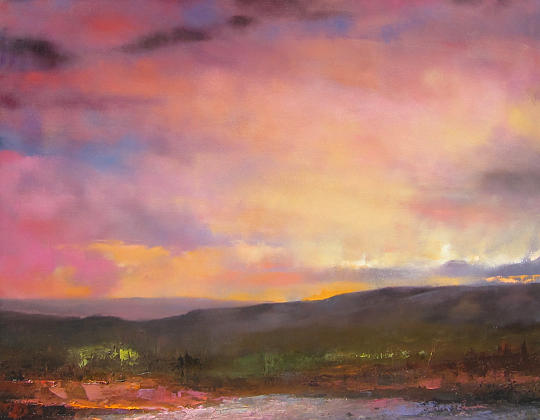The World Through Rose Colored Glasses
Question: What kind of world is it when you don’t see black, grey, and brown?
Answer: It’s the world of colorists and expressionist landscape painters.
 |
| Desert Oasis 24.5" x 30.5" by Michelle Chrisman |
And what a lovely world it is. I know that personally, I ‘m attracted to high color. The primaries are my friends, and I don’t want much to do with those “sad,” muted colors.
In my last post, I wrote about landscape as a personal vision. I noticed that there are some other landscape painters at Wilde Meyer who express how they feel when they look at a scene, rather than try to reproduce it. These painters feel really good!
Michelle Chrisman does the majority of her painting outdoors in New Mexico. “Part of the enjoyment for me is to be outside, to paint quickly and record my emotional response to what I’m seeing,” she said. “I love to get in the zone, surrounded by nature, and paint alla prima, that is, wet on wet, finishing in one session.” Her painting entitled “Desert Oasis,” shown at the top of this post, is a good example of her fresh style. It’s as if she took in her surroundings and expressed it in just a moment, to say how it affected her.
Michelle is a colorist who “hyper sees,” that is, she sees the hues that make up the local color others perceive. She’s very interested in the effect of light and spectral color, which is defined by Wikipedia as “a color that is evoked by a single wavelength of light in the visible spectrum, or by a relatively narrow band of wavelengths. The spectrum is often divided up into named colors: red, orange yellow, green, blue and violet.”
 |
| Kitchen Mesa 24.5" x 30.5" by Michelle Chrisman |
You can see Michelle’s technique and color vision in her painting entitled “Kitchen Mesa.” It was painted at Ghost Ranch, the site of many of Georgia O’Keeffe’s paintings. I like the wonderful reds and yellows she uses to show warmth and light, and the soft violets to indicate the shadow of the rock crevices. The blue/green hue in the foreground really pops against the red tones around it. In addition to strong color, Michelle uses heavy texture with a palette knife to describe her landscape.
“For me, paint is part of the experience,” she said. “I want it to be luscious, to say ‘I’m paint, touch me!’”
Barbara Gurwitz wants to create a sense of place in her landscape paintings. She takes photos and does sketches of the special places she wants to paint. But realism takes a back seat to the expression of how she felt at the time of her visit to the site. “I’m not interested in duplicating the colors of nature,” she said. “I’ve always chosen colors that speak to the way I see the world, which are sometimes different from what you would expect.”
 |
| View from the West 24" x 30" by Barbara Gurwitz |
 |
| High Country Summer 40" x 60" by Barbara Gurwitz |
 |
| Santa Cruz Autumn 34" x 44" by Barbara Gurwitz |
When Barbara paints, she often calls upon her spiritual mentor, Vincent Van Gogh (who wasn’t quite as upbeat as she). “I love his willingness to paint as he saw fit, and he’s always been an inspiration to me.”
Leigh Gusterson learned to paint in New Jersey and was trained in the Hudson River style of plein air painting. “It was grey and humid a lot of the time, and my paintings reflected that weather.” But things changed when she relocated to Taos and experienced the effect of the light there. Now, Leigh loves to push color when she paints on location at her favorite sites.
 |
| Hollyhock Morning 9.25" x 12" by Leigh Gusterson |
“As artists, we train our eyes to see shapes, form and color more intensely,” Leigh said. “I like to share what I see with viewers of my artwork.” Even though Leigh uses non-traditional colors (as in “Hollyhock Morning”), she said that her palette is simple, with just 12-14 colors. “I can make anything I want with these colors,” she explains. “And, sometimes, it’s just the awesome New Mexican landscape that displays these amazing colors!” She said the pink cliffs in “Magpie Playground” really exist.
 |
| Magpie Playground 17.25" x 21.5" by Leigh Gusterson |
Like Barbara, Leigh enjoys painting scenes of villages nestled in the mountain foothills, with their farms, houses and church. She, too, chooses to wear rose-colored glasses, and infuses some of her work with a sense of whimsy, as in “Drive By Sheep.”
 |
| Drive By Sheep 27.5" x 27.5" by Leigh Gusterson |
So, if you’re living in the southwest, take a drive to a favorite spot and look again. You, too, may see some amazing colors you’ve never noticed there before.






















